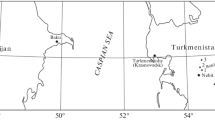Abstract
A large new edrioasteroid genus from the Seifen Formation (Lower Devonian, Germany), Seifenia gen. nov., is introduced. The type species, S. ostara sp. nov., is described and figured, and its systematic position is discussed. Seifenia shows a highly derived evolutionary position in comparison with other Lower Devonian genera. With a diameter up to 57 mm, it is the largest known domal genus of the Agelacrinitidae. Most specimens of S. ostara are not found in contact with the substrate. Possible reasons for this phenomenon are discussed. Furthermore, synecological interactions of Seifenia with brachiopods and auloporid corals are documented.






Similar content being viewed by others
References
Bassler, R.S. 1936. New species of American Edrioasteroidea. Smithsonian Miscellaneous Collections 95(6): 1–31.
Bell, B.M. 1976. A study of North American Edrioasteroidea. New York State Museum and Science Service. Memoir 21: 1–446.
Billings, E. 1858. On the Austeriaidae of the Lower Silurian rocks of Canada. Geological Survey of Canada. Figures and Descriptions of Canadian Organic Remains. Decade 3: 75–85.
Chapman, E.J. 1860. On a new species of Agelacrinites and on the structural relations of that genus. Canadian Journal of Industry, Science and Art 5: 358–365.
Drevermann, F. 1904. Die Fauna der Siegener Schichten von Seifen unweit Dierdorf (Westerwald). Palaeontographica 50: 229–287.
Grigo, M. 1995. Agelacrinites curvatus n. sp., ein Edrioasteroide (Echinodermata) aus Oberen Siegener Schichten des nördlichen Westerwaldes, Rheinisches Schiefergebirge. Paläontologische Zeitschrift 69(1/2): 223–232.
Grigo, M. 1997. „Dingeria” devonica Dahmer 1934, eine Fenestelliden-Basis aus den Seifen Schichten des nördlichen Westerwaldes (Unter-Devon; Rheinisches Schiefergebirge). Coral Research Bulletin 5: 277–282.
Guensberg, T.E. 1988. Systematic, functional morphology, and live modes of late Ordovician edrioasteroids, Orchard Creek Shale, southern Illinois. Journal of Paleontology 62(1): 110–126.
Guensberg, T.E., and J. Sprinkle. 1994. Revised phylogeny and functional interpretation of the Edrioasteroidea based on new taxa from the Early and Middle Ordovician of western Utah. Fieldiana Geology 29: 1–43.
Holloway, D.J., and P.A. Jell. 1983. Silurian and Devonian edrioasteroids from Australia. Journal of Paleontology 57(5): 1001–1016.
Jansen, U. 2016. Brachiopod faunas, facies and biostratigraphy of the Pridolian to lower Eifelian succession in the Rhenish Massif (Rheinisches Schiefergebirge, Germany). Geological Society, London, Special Publications 423: 45–122.
Kammer, T.W., C.D. Sumrall, S. Zamora, W.I. Ausich, and B. Deline. 2013. Oral region homologies in Paleozoic crinoids and other plesiomorphic pentaradial echinoderms. PLoS One 8(11): e77989. (16 pp).
Meek, F.B., and A.H. Worthen. 1868. Remarks on some types of Carboniferous Crinoidea, with descriptions of new genera and species of the same, and one echinoid. Philadelphia Academy of Natural Science, Proceedings 5: 335–359.
Meyer, D.L. 1990. Population paleoecology and comparative taphonomy of two edrioasteroid (Echinodermata) pavements; upper Ordovician of Kentucky and Ohio. Historical Biology 4: 155–178.
Miller, S.A. 1891. Paleontology. Geological Survey of Indiana, 17th Annual Report (Advanced Publication), 1–103.
Müller, P., and G. Hahn. 2010. Edrioasteroidea aus den Seifen-Schichten im Westerwald, Rheinisches Schiefer-Gebirge (Unter-Devon, Deutschland). Teil 1. Geologica et Palaeontologica 43: 9–47.
Müller, P., and G. Hahn. 2017a. Edrioasteroidea of the Seifen Formation in the Westerwald, Rhenish Slate Mountains (Lower Devonian, Germany), Part 2: Sumrallia rseiberti gen. et sp. nov. PalZ. Paläontologische Zeitschrift 91: 629–639.
Müller, P., and G. Hahn. 2017b. Grigopyrgus n. gen., a new agelacrinitid genus from the Lower Devonian of the Westerwald (Echinodermata, Rhenish Slate Mountains, Germany). Mainzer Geowissenschaftliche Mitteilungen 45: 93–102.
Müller, P., and G. Hahn. 2018. Edrioasteroidea aus der Seifen-Formation im Westerwald, Rheinisches Schiefergebirge (Unter-Devon, Deutschland), Teil 3: Westerwalddiscus poschmanni gen. et sp. nov. Mainzer geowissenschafliche Mitteilungen 46: 23–40.
Shroat-Lewis, R.A., E.N. Greenwood, and C.D. Sumrall. 2019. Paleoecologic analysis of edrioasteroid (Echinodermata) encrusted slabs from thr Chesterian (Upper Mississippian) Kinkaid Limestone of Southern Illinois. Palaios 34: 146–158.
Smith, A., and M.A. Arbizu. 1987. Inversal larval development in a Devonian edrioasteroid from Spain and the phylogeny of the Agelacrinitidae. Lethaia 20(1): 49–62.
Sumrall, C.D. 1996. Late Paleozoic Edrioasteroidea (Echinodermata) from the North American midcontinent. Journal of Paleontology 70(6): 969–985.
Sumrall, C.D. 2001. Paleoecology and taphonomy of two new edrioasteroids from a Mississippian hardgroud in Kentucky. Journal of Paleontology 75(1): 136–146.
Sumrall, C.D., and A.L. Bowsher. 1996. Giganticlavus, a new genus of Pennsylvanian edrioasteroid from North America. Journal of Paleontology 70(6): 986–993.
Sumrall, C.D., J. Garbisch, and J.P. Pope. 2000. The systematics of postibullinid edrioasteroids. Journal of Paleontology 74(1): 72–83.
Sumrall, C.D., and R.L. Parsley. 2003. Morphology and biomechanical implications of isolated discocystinid plates (Edrioasteroida, Echinodermata) from the Carboniferous of North America. Palaeontology 46: 113–138.
Sumrall, C.D., and J. Sprinkle. 1992. Could edrioasteroids move? Fifth North American Paleontological Convention, Abstracts and Program: p. 284.
Sumrall, C.D., J. Sprinkle, and R.M. Bonem. 2006. An edrioasteroid-dominated echinoderm assemblage from a Lower Pennsylvanian marine conglomerate in Oklahoma. Journal of Paleontology 80(2): 229–244.
Sumrall, C.D., and A.J. Waters. 2012. Universal elemental homology in glyphocystoids, hemicosmitoids, coronoids and blastoids: steps towards echinoderm phylogenetic reconstruction in derived Blastozoa. Journal of Paleontology 86(6): 956–972.
Sumrall, C.D., and S. Zamora. 2011. Ordovician edrioasteroids from Morocco: faunal exchanges across the Rheic Ocean. Journal of Systematic Palaeontology 9: 425–454.
Sumrall, C.D., and S. Zamora. 2018. New Upper Ordovician edrioasteroids from Marocco. Geological Society of London, Special Publication 485: 1–13.
Acknowledgements
We would like to thank Ralph Seibert (Ransbach-Baumbach) for the opportunity to study this important material and for being able to deposit specimens in the Landessammlung für Naturkunde Rheinland-Pfalz (Mainz). Many thanks also to Ulrich Jansen (Forschungsinstitut Senckenberg, Frankfurt) for detailed information about brachiopods. Help with the English text was provided by Markus Poschmann (Koblenz). We are especially grateful to the reviewers Thomas E. Guensburg (Field Museum Chicago, Illinois), Colin Sumrall (University of Tennessee, Knoxville, Tennessee) and Mike Reich (Ludwig-Maximilians University, Munich) for their helpful comments on this text.
Author information
Authors and Affiliations
Corresponding author
Additional information
Handling Editor: Mike Reich.
Rights and permissions
About this article
Cite this article
Müller, P., Hahn, G. A new large edrioasteroid from the Seifen Formation of the Westerwald, Rhenish Massif (Lower Devonian, Germany). PalZ 94, 715–724 (2020). https://doi.org/10.1007/s12542-020-00526-7
Received:
Accepted:
Published:
Issue Date:
DOI: https://doi.org/10.1007/s12542-020-00526-7




